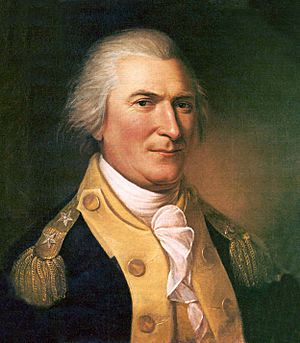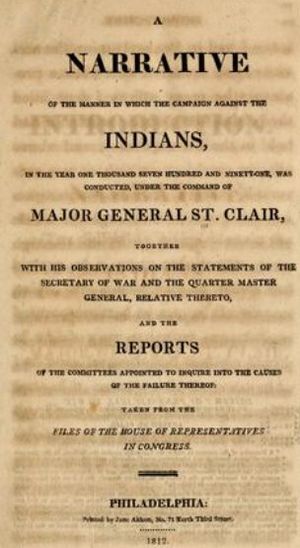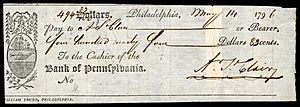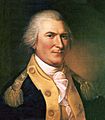Arthur St. Clair facts for kids
Quick facts for kids
Arthur St. Clair
|
|
|---|---|

Portrait by Charles Willson Peale, c. 1783
|
|
| 1st Governor of the Northwest Territory | |
| In office July 15, 1788 – November 22, 1802 |
|
| Preceded by | Position established |
| Succeeded by | Charles Willing Byrd |
| 7th President of the Confederation Congress | |
| In office February 2, 1787 – November 4, 1787 |
|
| Preceded by | Nathaniel Gorham |
| Succeeded by | Cyrus Griffin |
| Personal details | |
| Born | March 23, 1737 Thurso, Caithness, Scotland, Great Britain |
| Died | August 31, 1818 (aged 81) Greensburg, Pennsylvania, U.S. |
| Resting place | St. Clair Park, Greensburg |
| Alma mater | University of Edinburgh |
| Signature | |
| Military service | |
| Allegiance |
|
| Branch/service |
|
| Rank |
|
| Battles/wars | |
Arthur St. Clair (born March 23, 1737 – died August 31, 1818) was an important soldier and politician from Scotland who later became an American citizen. He was born in Thurso, Scotland.
He first served in the British Army during the French and Indian War. After the war, he moved to Pennsylvania and held local government jobs. During the American Revolutionary War, he became a major general in the Continental Army. However, he lost his command after a difficult retreat from Fort Ticonderoga.
After the war, he became the President of the Continental Congress. During his time, an important law called the Northwest Ordinance was passed. In 1788, he became the first governor of the Northwest Territory. This huge area later included Ohio. In 1791, St. Clair led American forces in a major defeat by Native Americans. He was removed as governor in 1802 because his political views differed from the new president, Thomas Jefferson.
Contents
Arthur St. Clair's Early Life and Military Career
Arthur St. Clair was born in Thurso, Caithness, Scotland. Not much is known about his very early years. He was likely born on March 23, 1737. His parents were probably William Sinclair, a merchant, and Elizabeth Balfour. He reportedly studied at the University of Edinburgh. He also trained with a famous doctor named William Hunter.
In 1757, St. Clair joined the British Army. He bought a "commission," which meant he paid money to become an officer. He came to America with Admiral Edward Boscawen's fleet to fight in the French and Indian War. He served under General Jeffery Amherst when the British captured Louisburg, Nova Scotia, in 1758. In 1759, he became a lieutenant. He then served under General James Wolfe at the Battle of the Plains of Abraham. This battle led to the capture of Quebec City.
Moving to America and Public Service
On April 16, 1762, St. Clair left the British Army. In 1764, he settled in Ligonier Valley, Pennsylvania. He bought a lot of land there and built mills. He became the biggest landowner in Western Pennsylvania.
In 1770, St. Clair took on many important roles in the local government. He became a judge and held several other official positions in Bedford and Westmoreland counties.
In 1774, the colony of Virginia claimed land around Pittsburgh. Some people in Western Pennsylvania were ready to fight over it. St. Clair ordered the arrest of the Virginia officer leading the troops. This land dispute was eventually settled by a conflict known as Lord Dunmore's War.
Arthur St. Clair and the Revolutionary War
By the mid-1770s, St. Clair felt more like an American than a British subject. In January 1776, he joined the Continental Army. He became a colonel in the 3rd Pennsylvania Regiment. He first served during the Quebec invasion. He fought in the Battle of Trois-Rivières.
In August 1776, he was promoted to brigadier general. General George Washington sent him to help organize the New Jersey militia. St. Clair was part of George Washington's crossing of the Delaware River on December 25–26, 1776. This happened just before the Battle of Trenton on December 26. Many historians believe St. Clair helped plan the strategy that led to Washington's capture of Princeton in January 1777. St. Clair was promoted to major general in February 1777.
In April 1777, St. Clair was sent to defend Fort Ticonderoga. His small group of soldiers could not hold off the larger British force led by General John Burgoyne. St. Clair had to retreat from Fort Ticonderoga on July 5, 1777. He pulled his forces back and did not take part in the rest of that campaign. In 1778, he faced a military trial, called a court-martial, for losing Ticonderoga. The court found him innocent, and he returned to duty. However, he was no longer given commands in battles. He still served as an aide-de-camp (a personal assistant) to General Washington. Washington still trusted him greatly. St. Clair was at Yorktown when Lord Cornwallis surrendered his army.
Leading the Confederation Congress
St. Clair was a member of the Pennsylvania Council of Censors in 1783. He was then chosen as a delegate to the Confederation Congress. He served from November 1785 to November 1787. In early 1787, there was a lot of unrest, including Shays' Rebellion. States were also not agreeing on land issues or helping the federal government.
On February 2, 1787, the delegates finally gathered enough members to vote. They elected St. Clair to be the President of the Continental Congress for one year. During his time as president, Congress passed its most important law, the Northwest Ordinance. However, the Confederation Congress was nearing its end. While St. Clair was president, the Philadelphia Convention was creating a new United States Constitution. This new Constitution would replace the old Congress.
Governing the Northwest Territory

The Northwest Ordinance of 1787 created the Northwest Territory. General St. Clair was appointed as its governor. This territory included what is now Ohio, Indiana, Illinois, Michigan, and parts of Wisconsin and Minnesota. He named Cincinnati, Ohio, after the Society of the Cincinnati. He made Cincinnati his home.
As governor, he helped create the first written laws for the territory, known as Maxwell's Code. He also wanted to end Native American claims to land in Ohio. This would clear the way for white settlers. In 1789, he got some Native Americans to sign the Treaty of Fort Harmar. However, many important Native American leaders were not invited or refused to join the talks. This treaty did not settle the land claims. Instead, it led to more fighting in what is called the "Northwest Indian War."
In October 1790, General Josiah Harmar led a campaign against the Native Americans. His 1,500 soldiers were defeated. In March 1791, St. Clair took over from Harmar as commander of the United States Army. He was made a major general. He personally led an expedition with regular army soldiers and some militia. In October 1791, Fort Jefferson (Ohio) was built as a supply post for his campaign.
One month later, on November 4, 1791, his forces were attacked. This happened near what is now Fort Recovery. A group of Native American tribes led by Miami Chief Little Turtle and Shawnee chief Blue Jacket defeated St. Clair's army. They were helped by British allies Alexander McKee and Simon Girty. More than 600 American soldiers and civilians were killed in this battle. It is known as "St. Clair's Defeat" or the "Battle of the Wabash." It is still the worst defeat of a US Army by Native Americans in history. About 623 American soldiers died, and about 50 Native Americans were killed. Many were wounded, including St. Clair himself.
Even though an investigation cleared him, St. Clair resigned from the army in March 1792. President Washington asked him to. However, he continued to serve as Governor of the Northwest Territory.
St. Clair was a member of the Federalist political party. He hoped to create two states from the Ohio Territory. This would increase Federalist power in the Congress. However, people in Ohio who supported the Democratic-Republican party opposed him. They felt he was too biased and arrogant in his role. In 1802, St. Clair said that the U.S. Congress had no right to interfere in the Ohio Territory's affairs. He also stated that the people there were not bound by Congress's acts. Because of this, President Thomas Jefferson removed him from his position as territorial governor. So, St. Clair was not involved in Ohio becoming a state in 1803.
The first Ohio Constitution created a weak governor and a strong legislature. This was partly a reaction to how St. Clair had governed.
Arthur St. Clair's Family Life
Arthur St. Clair married Phoebe Bayard in 1760. She was from a very important family in Boston. Phoebe's mother was the sister of James Bowdoin, who was a colonial governor of Massachusetts.
His oldest daughter was Louisa St. Clair Robb. She was known as a skilled horse rider and scout. She was also known for being a beautiful huntress.
Like many people from his time, St. Clair suffered from a health condition called gout. This is mentioned in letters he wrote to John Adams.
Later Years and Death
In his retirement, Arthur St. Clair lived with his daughter, Louisa St. Clair Robb, and her family. They lived on a ridge between Ligonier and Greensburg, Pennsylvania.
Arthur St. Clair died in Greensburg, Pennsylvania, on August 31, 1818. He was 81 years old and died in poverty. He is buried under a Masonic monument in St. Clair Park in downtown Greensburg. His wife Phoebe died shortly after him and is buried next to him.
Arthur St. Clair's Legacy
A part of the Hermitage, St. Clair's home in Oak Grove, Pennsylvania, was moved to Ligonier. It is now preserved at the Fort Ligonier Museum. The museum also has artifacts and items that belonged to St. Clair.
An American Civil War ship was named USS St. Clair.
Many places are named in honor of Arthur St. Clair, including:
In Pennsylvania:
- Upper St. Clair, Pennsylvania
- St. Clairsville, Pennsylvania
- St. Clair, Schuylkill County, Pennsylvania
- St. Clair Township, Westmoreland County, Pennsylvania
- East St. Clair Township, Bedford County, Pennsylvania
- West St. Clair Township, Bedford County, Pennsylvania
- The St. Clair neighborhood in Pittsburgh, Pennsylvania
- St. Clair Hospital, Mt. Lebanon, Pennsylvania
In Ohio:
- St. Clair Township in Butler County, Ohio
- St. Clair Township in Columbiana County, Ohio
- St. Clairsville, Ohio
- St. Clair Avenue in Cleveland, Ohio
- St. Clair Street in Dayton, Ohio
- St. Clair Street in Toledo, Ohio
- Fort St. Clair in Eaton, Ohio
Other States:
- St. Clair County, Illinois
- St. Clair Street in Indianapolis, Indiana
- St. Clair County, Missouri
- St. Clair County, Alabama
- St. Clair Street in Frankfort, Kentucky. This street was named for St. Clair by General James Wilkinson.
In Scotland:
Images for kids
-
Portrait by Charles Willson Peale, c. 1783
-
A Narrative printed by Jane Aitken




